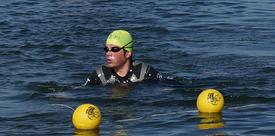Weighing pasta

babygooshzarn
Posts: 10 Member
This is probably a dumb question. Do you weigh pasta before or after cooking? And if it IS before, than what do you do if you're making a big pot for the whole family? How do you figure out how much to get?
0
Replies
-
You weigh it before cooking. If you look on the package, it tells you the serving size and calories in dry weight. Make sure you weigh it on a scale, don't go by cups. In my experience, the only way to know how much cooked pasta is an accurate serving is to make yours by itself in a separate pot.0
-
Yes, pasta is a pain the butt to log. I agree that the best way to do it is to make your portion separately. Or, you could count how many noodles in a dry serving and then count out that many noodles after they're cooked, but that is a lot of extra effort (trust me, I've done it....I don't know why).
0 -
I weigh before I cook it, and I will cook my portion separate from the rest. Because it absorbs water as you cook it, some days cooked weight may weigh more and some days less. I have taken the weight of my cooked portion so that days where I'm just in a hurry or don't feel like adding another dish to the pile, I will weigh out after it's cooked, but I'm usually after accuracy, so I just deal with the extra pot.0
-
My suggestion is to weigh out one serving and then boil it by itself. Then drain the water and put it in a measuring cup to see how much you get. If you normally use the same kind of pasta over and over, you can then measure out that amount after cooking each time and rest assured that your post-cooking measurement is reasonably accurate. I did this myself and found that one serving of uncooked spaghetti comes out to just over a cup of cooked pasta (1 cup measuring cup was full and slightly rounded.) I just measure my spaghetti servings out that way.0
-
I weigh out two portions (just me and DH) dry. Then when its done cooking, I dump it all into one bowl and divide it in half by weight. DH is ok with eating 1 actual serving of pasta (instead of 2-3 servings like most people do).
As long as you know how many servings you cooked (weight it dry before you dump it in), you can divide the total cooked weight by that many servings and just eat one serving. This way you can cook extra servings for everyone else, but you still know how much one serving is.0 -
Someone recommended cooking your weighed version separated by a metal strainer directly in the same pot as the family's pasta. I thought it was brilliant!0
-
I divide total number of calories in dry pasta by the amount by weight in the package (so total calories in package/weight of package)
That gives me calories per ounce (or gram).
I then weight the amount of dry pasta I am cooking if it isn't the entire package.
Amount going into the pot by weight * calories per weight unit = total calories in the pot
Cook the pasta.
Drain it.
Weigh cooked pasta.
Determine fraction of total you are going to eat. Maybe 1/4 (for our example).
Measure onto your plate 1/4 of the cooked pasta by weight.
Total calories on your plate will be Total Calories in the Pot * .25
Sounds complicated, but it isn't when you get used to it. Weigh everything. Do math (math is our friend!). I have to cook not just for my diet, but for my family with various allergies and dietary needs (one of my daughters actually needs extra calories right now, her BMI has dipped low as she grows fast!
I make 3 or 4 "versions" of the same meal most nights, not due to pickiness. Cooking from scratch is not optional for my family.
Another thing I do for making casseroles is keep a running total on a scratch pad of total calories in the pan as I add items (almost always by weight, volume is not as accurate). Then, determine calories per ounce for the entire pan. Weight portion and multiply by that. That gives calories on your plate.
(Biggest issue is if the food is very chunky, your serving might not be a homogenous enough sample to have accurate calories.. like if you take the piece with extra cheese on top. So try to take an "average" piece).
The last thing I do sometimes is make a new recipe in the food section. Add all your ingredients. Make the servings number equal to the ounces total of your recipe (so, say 75 oz. would be 75 "servings"). Weigh what is on your plate. Add that many "servings" to your log (say, 12 "servings" or oz.) This makes MFP do a lot of the math.
(Another hint is to weigh all your most common dishes and pans and keep a list in your kitchen. That way, if you forget to "zero" or "tare" the weight, you will still be able to calculate how much the contents weigh.)
Hope all this makes sense. I lost 60 lbs with MFP 2 years ago. Gained most back with a bout of clinical depression. Feeling mentally well again, and working on re-loosing the weight. 10 lbs down in a month so far.
0 -
Pasta is so annoying that I often avoid it just because I don't wanna deal with weighing/logging it, lol. But the most accurate method is just to cook your dry-weighed serving in its own pot. Every time you cook it it may absorb a different amount of water, so cooked weight will vary. Dry weight is always the same.0
-
Plus it's such a small amount of pasta per serving size that it's just depressing. I'd rather do spaghetti squash and pretend it's real spaghetti and eat a gargantuan size bowl for like, 100 calories, lol0
-
ecoforestry wrote: »I divide total number of calories in dry pasta by the amount by weight in the package (so total calories in package/weight of package)
That gives me calories per ounce (or gram).
I then weight the amount of dry pasta I am cooking if it isn't the entire package.
Amount going into the pot by weight * calories per weight unit = total calories in the pot
Cook the pasta.
Drain it.
Weigh cooked pasta.
Determine fraction of total you are going to eat. Maybe 1/4 (for our example).
Measure onto your plate 1/4 of the cooked pasta by weight.
Total calories on your plate will be Total Calories in the Pot * .25
Sounds complicated, but it isn't when you get used to it. Weigh everything. Do math (math is our friend!). I have to cook not just for my diet, but for my family with various allergies and dietary needs (one of my daughters actually needs extra calories right now, her BMI has dipped low as she grows fast!
I make 3 or 4 "versions" of the same meal most nights, not due to pickiness. Cooking from scratch is not optional for my family.
Another thing I do for making casseroles is keep a running total on a scratch pad of total calories in the pan as I add items (almost always by weight, volume is not as accurate). Then, determine calories per ounce for the entire pan. Weight portion and multiply by that. That gives calories on your plate.
(Biggest issue is if the food is very chunky, your serving might not be a homogenous enough sample to have accurate calories.. like if you take the piece with extra cheese on top. So try to take an "average" piece).
The last thing I do sometimes is make a new recipe in the food section. Add all your ingredients. Make the servings number equal to the ounces total of your recipe (so, say 75 oz. would be 75 "servings"). Weigh what is on your plate. Add that many "servings" to your log (say, 12 "servings" or oz.) This makes MFP do a lot of the math.
(Another hint is to weigh all your most common dishes and pans and keep a list in your kitchen. That way, if you forget to "zero" or "tare" the weight, you will still be able to calculate how much the contents weigh.)
Hope all this makes sense. I lost 60 lbs with MFP 2 years ago. Gained most back with a bout of clinical depression. Feeling mentally well again, and working on re-loosing the weight. 10 lbs down in a month so far.
Package weight is often not accurate though.
I put the package on the scale, turn it on. It shows 0. I dump the pasta in the pot (whatever amount I want) then put the package back on the scale. It will show how many grams of pasta you used (example -480g).
I divide that number by the serving size (56g) to figure out how many servings I'm cooking... so 480/56= 8.57 servings.
Then once it's cooked and drained, I weigh it again (I put a bowl on the scale and tare it). Let's say it's now 1000g. I divide that number by the number of servings... so 1000/8.57 = 116.7g.
So now I know that a serving is 116g (I just round it down). To log it, I just take a '2oz serving' entry, and use that, knowing that it's really 116g now.... So if I end up taking 200g of pasta, I'll just do 200/116 and log 1.75 of a serving.
Or yeah you could just cook your serving in another pan, but meh, this doesn't really take much longer.
You need a scale, obviously.0 -
I do similar to what Franl27 does. I weigh out servings before hand, say 4x servings.
Cook it
Weigh it again, lets say it weighs 400g after cooking I divide by the number of servings I put into the pot. I'll then take 100g as a serving.0 -
I weigh out all of the pasta when it's dry to figure out how many servings I have. Then, once it's finished cooking, grab a bowl, dump the cooked pasta into it, and divide it by the number of servings.
Example: if you're making 3 servings of pasta, weigh out 6 oz total of dry pasta (2 oz per serving). Then cook the pasta. After its cooked, weigh it again, and divide that total weight by 3.0 -
Queenmunchy wrote: »Someone recommended cooking your weighed version separated by a metal strainer directly in the same pot as the family's pasta. I thought it was brilliant!
Seriously, that is genius.0
This discussion has been closed.
Categories
- All Categories
- 1.4M Health, Wellness and Goals
- 398.1K Introduce Yourself
- 44.7K Getting Started
- 261K Health and Weight Loss
- 176.4K Food and Nutrition
- 47.7K Recipes
- 233K Fitness and Exercise
- 462 Sleep, Mindfulness and Overall Wellness
- 6.5K Goal: Maintaining Weight
- 8.7K Goal: Gaining Weight and Body Building
- 153.5K Motivation and Support
- 8.4K Challenges
- 1.4K Debate Club
- 96.5K Chit-Chat
- 2.6K Fun and Games
- 4.8K MyFitnessPal Information
- 12 News and Announcements
- 21 MyFitnessPal Academy
- 1.5K Feature Suggestions and Ideas
- 3.2K MyFitnessPal Tech Support Questions











